Popular Science (1967): My LSD Trip: A non-cop non-hippie report of the unvarnished facts
Here is a rare issue of Popular Science from 1967, in which a journalist is injected with LSD and trips his face off for the benefit of the American Public. I had assumed Popular Science was a conservative periodical for men with soldering irons, but this LSD article is surprisingly balanced and open-minded on the topic of psychedelics. The magazine originally sold for 35 cents.
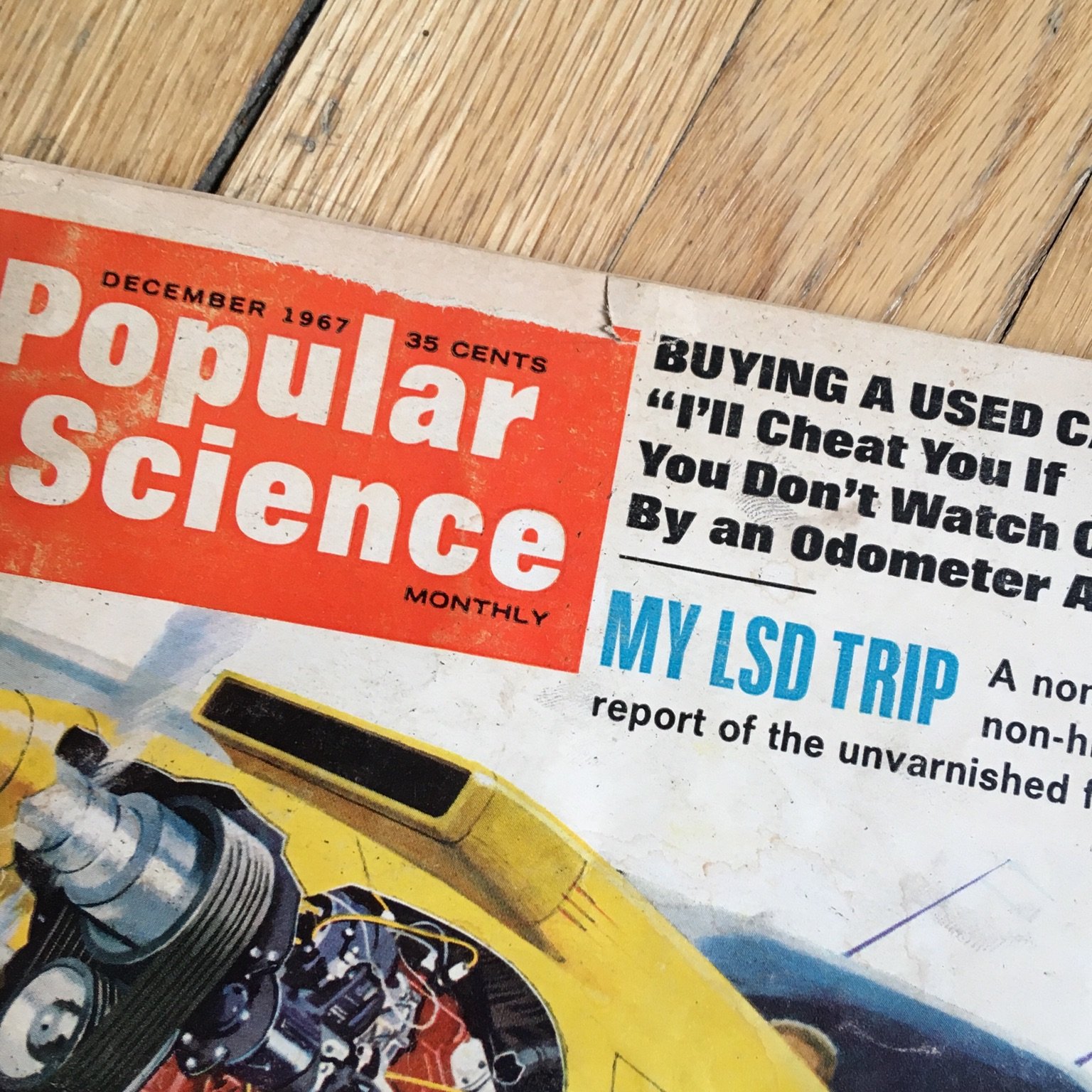
The article bills itself as a 'non-cop non-hippie report of the unvarnished facts' and is, in fact, precisely that. The writer, Robert Gannon, even had the good taste to contact LSD High Priest, Tim Leary, personally. As a result, the journalism here presents a very rational perspective. This is particularly impressive given that it was written in the midst of the 1960s national moral panic on the relatively harmless substance known as LSD-25.
Let's inject some LSD
We are told that Dr Karl A. Ray, injects our journalist, Gannon, with 173 micrograms of pure LSD. Nine minutes later Gannon is "off, swinging up in my beautiful balloon" (depicted below by illustrator Dana Rasmussen who seems to have had a lot of fun with this article). Dr Ray is years ahead of his time and has already intuited that the power of LSD to heal lies in the substance's ability to excavate old traumatic material for reprocessing and resolution. Dr Ray tells Popular Science: "The treatment has a lot to do with the recall of forgotten or repressed events, with insight, and with a re-evaluation of the patient's self-image".
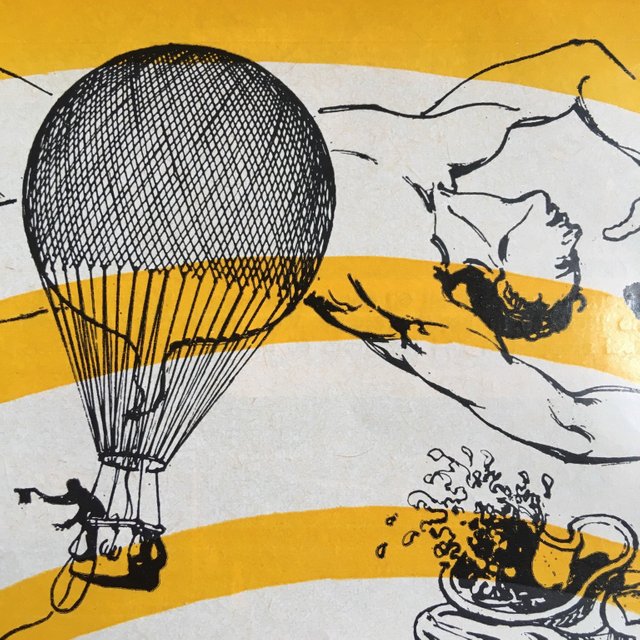
Dr Ray explains how LSD has been effective in treating alcoholics and others self-medicating for trauma because the sufferer, "may, for some elusive reason, suddenly understand why he has these problems, and what to do about them."
A modern reader with deep understanding of psychodynamics and contemporary trauma therapies may wonder why, given that Dr Ray appears to have the answer to society's ills, we were then thrown into a dark age of psychiatry that persists to this day?
Why was LSD made illegal?
Well, the answer is that the US Government realized that LSD caused increased consciousness, and increased consciousness was incompatible with war. The US Government were pretty intent on having a war with Vietnam and LSD was getting in the way of this commercial enterprise. Annoyingly, LSD seemed to make people resolve conflicts and love each other. So, everything possible was done to demonize LSD in the interests of the military-industrial complex.
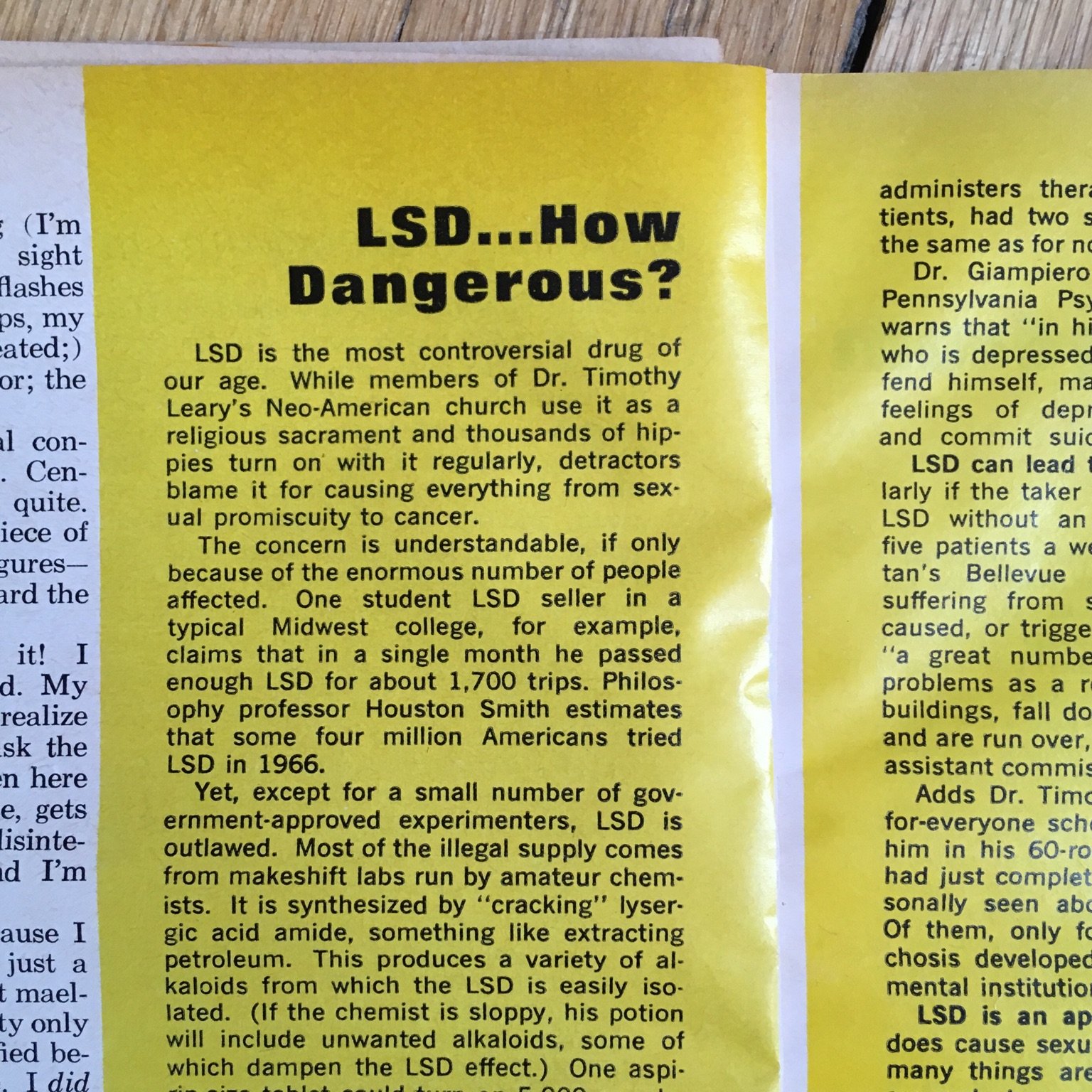
President Nixon oversaw this vilification of psychedelics in the 1960s. Years later the truth of what was going on was spoken by his own government, when one of Nixon’s top advisors, John Ehrlichman, revealed in 2016 that the US Government’s propoganda campaign against psychedelics was, in fact, simply manufactured to promote war and silence those who sought peace. As Ehrlichman revealed to Harper's magazine decades later:
“The Nixon campaign in 1968, and the Nixon White House after that, had two enemies: the antiwar left and black people.”
“You understand what I'm saying? We knew we couldn't make it illegal to be either against the war or be black, but by getting the public to associate the hippies with marijuana and blacks with heroin. And then criminalizing both heavily, we could disrupt those communities.... We could arrest their leaders. raid their homes, break up their meetings, and vilify them night after night on the evening news. Did we know we were lying about the drugs? Of course we did.”
Let's get back to this Popular Science article: It also addresses the propaganda surrounding LSD. Gannon speaks to Dr Charles Savage, Director of Research at Spring Grove State Hospital, who had been injecting patients with LSD for therapeutic purposes. Savage tells Popular Science that he had seen just two suicides in 15 years, "about the same as for non-LSD therapy".
A professional Trip Report
Our brave journalist, Gannon, soon finds himself deep in an LSD trip, swirling through "intellectual concepts: paradoxes, boxes in boxes. Centrifuges," eventually concluding, "I am totally insane."
In an attempt to regain his professional composure for the sake of thePopular Science readership, Gannon reaches haplessly for an orange juice. The first cup of juice, he crushes, his arm now a nonsensical mass of "muscles and tendons". Illustrator Dana Rasmussen, again, attempts to depict Gannon's struggle:
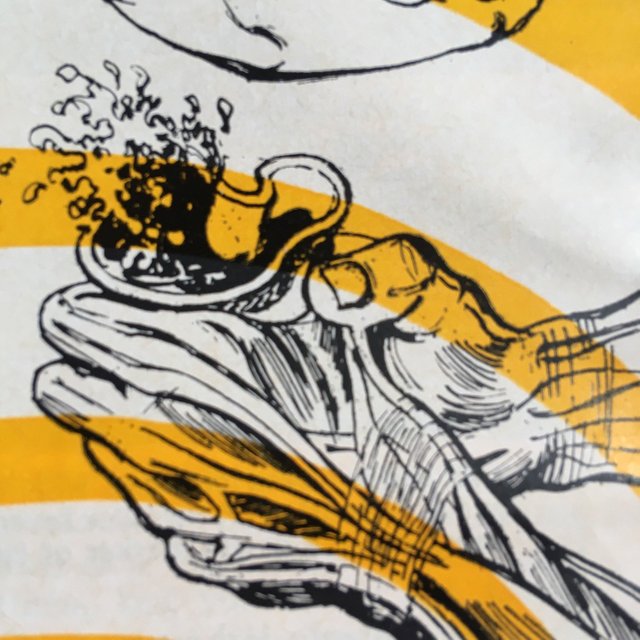
Finally Gannon gets the sacred juice vessel to his lips and reports that "...the taste, oh my God the taste. No one has ever tasted orange juice before. Maybe it's because the fluid is glowing — so bright I close my eyes."
All the while, Dr Ray maintains a formal composure and makes very scientific notes on Gannon like: "11:15 Patient dizzy. Resisting somewhat. Says "wow" a lot. Fascinated."
Later, illustrator Dana Rasmussen attempts to transmute Gannon's experience into something the Popular Science reader can digest. She comes up with this:
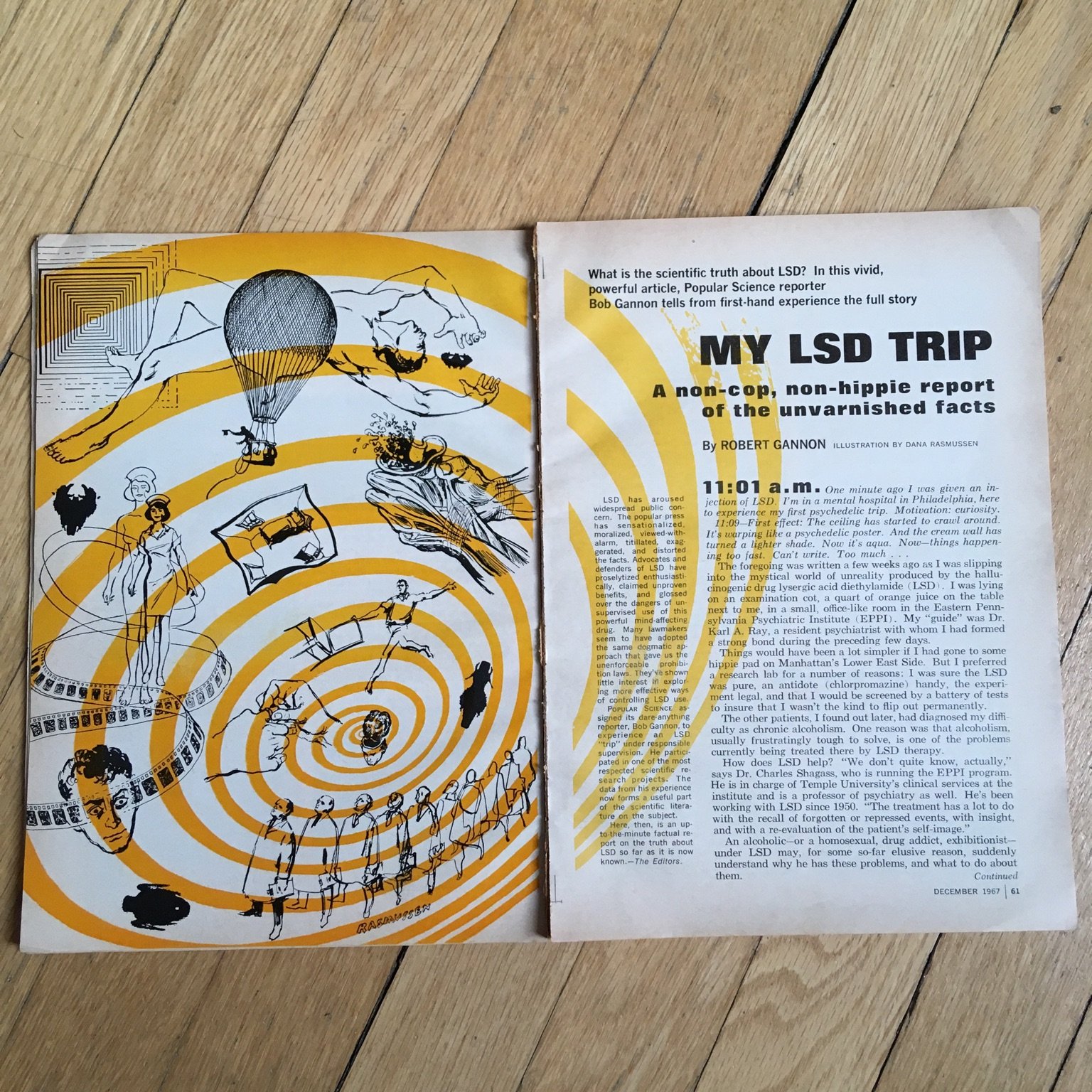
I think we can all agree that this issue of Popular Science was definitely worth 35 cents.
For more books and magazines like this, visit our bookshop and say hello. We accept payment for books and teas in Steem.
This post was brought to you by Kali, a community psychedelic bookshop and Café based in Berlin. We need your support to spread awareness and education about psychedelics. We believe these substances represent the most promising tool in modern medicine. You can take a look at the bookshop here, or visit us in person. Thanks for reading.
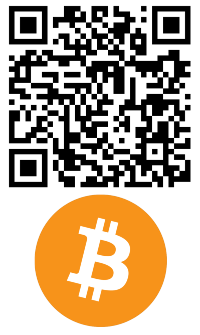
Most people's addictions are caused by traumas in early childhood.
Escape or self-medication is what an addiction is.
As a child, we had to bury the trauma in order to stay alive. Now, as an adult, we don't even remember the trauma was there. As an adult, being shown the scenes, the causes, the interconnections, allows you to rework those pathways crystallized as a child.
However, the problem with our (american) society is that we treat drugs whimsically, as entertainment, as a lark.
LSD, DMT, Ayahuasca are all much better after you have learned to meditate, gained some control over your mind and started working on your shadow self.
You got it exactly, @builderofcastles
Most of what our society calls 'mental illness' is likely just functional adaptation to trauma. And, like you say, addiction is often self-medication for trauma.
Also with you on the meditation. It's much easier to process material from the past when we have solid grounding in the present. Meditation is a great tool to enhance a psychedelic therapy experience.
Thank you for sharing your thoughts and experiences. You sound very awake.
definitely agree. most adults with traumatic pasts have never properly learned to deal with the lasting effects. Rather they seek to escape whether it be with psychedelics or drugs & alcohol. However the educated and balanced use of psychedelics I believe will lead our society to the mental elevation that we so need.
Thanks @kaliberlin for the excellent article. google 'Breaking Convention', the bi-anual conference on all things psychedelic held at Greenwich, England where you will meet old and young hippies rubbing shoulders with psychiatrists, neuroscientists, philosophers, shamen, artists, lawyers, police chiefs, journalists, acid chemists, pot farmers, musicians, yogis, scholars, comics, ethnologists and other interested parties. lots of videos from this conference are available on vimeo.
Thanks, @peteyates, for your support, and for the information on 'Breaking Convention'.
Highly rEsteemed!
Thank you @frankbacon :)
This is a magnificent article about an article.
I wonder, what is your reading of the paragraph about suicides. It seems to say that LSD is neither dangerous nor beneficial.
I must do an LSD someday.
Thank you @lenskonig
I think the doctor was presenting evidence against the idea that LSD increases risk of suicide (even this moderate perspective was radical in the 60s). But, you're right, it should, in theory, have reduced suicides. I would guess that either LSD is not effective in the face of such immediate and profound self-abandonment, or the tool and its method of use was still in its infancy.
LSD contributed to eliminating suicidal thoughts in many people I know, including myself. It's hard to put exact figures on this until research begins again on a large scale.
The other tricky thing is that the sitter can be as important as the substance. So there could be huge variations in effectiveness that have nothing directly to do with the LSD itself.
Before a person experiences LSD it might be enjoyable to read some of the great books on this subject, like Stanislav Grof's LSD Psychotherapy.
Thank you for reading.